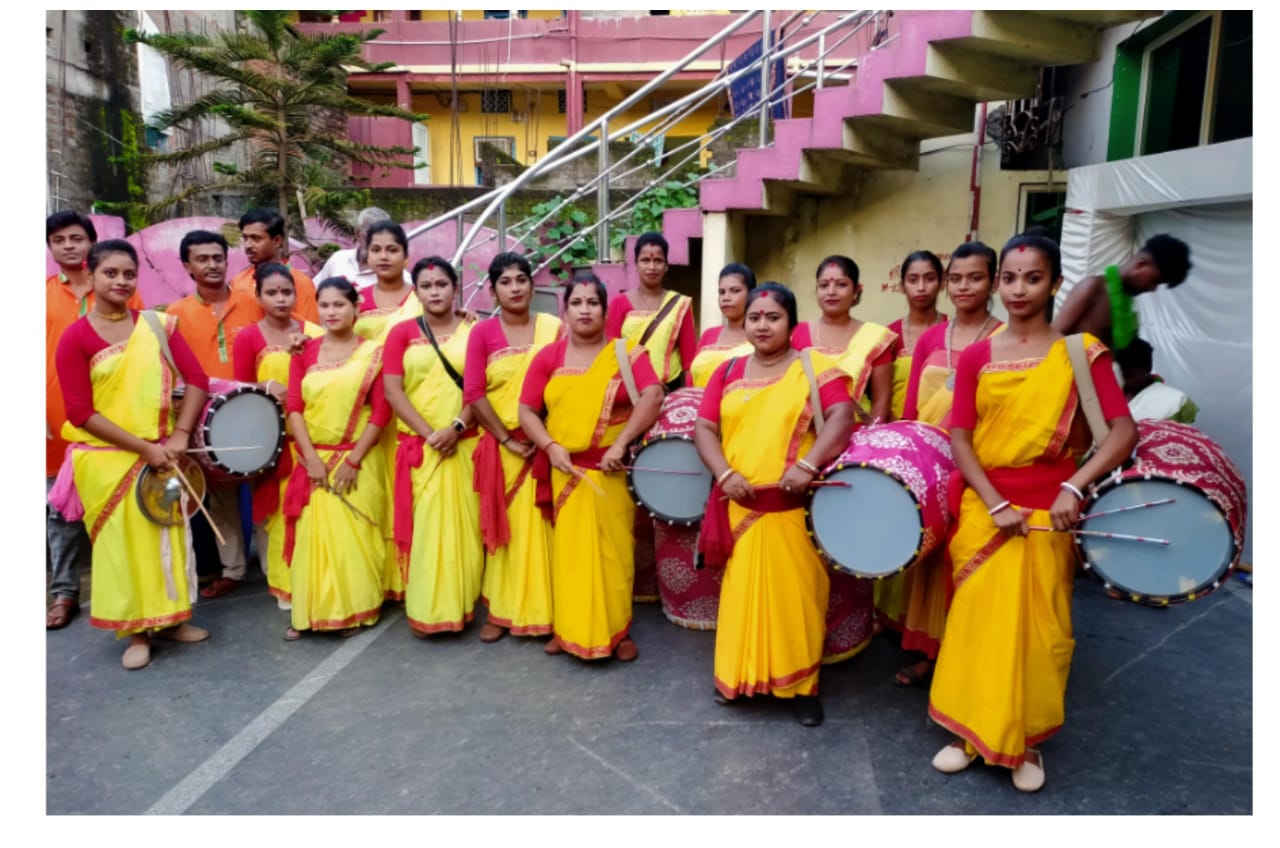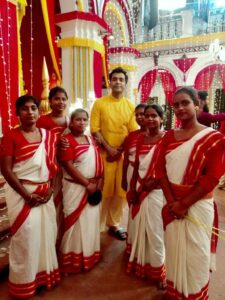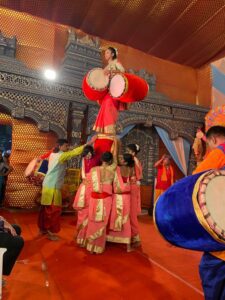In Hyderabad, the eight-lakh strong Bengali population has always tried its best to uphold their traditions of Durga Puja.

Members of the Bhabatarini Mahila Dhaki Sampradaya. (Supplied)
Durga is worshipped as Adi Shakti or the one in Eternal Power. The Bengalis in Hyderabad are no exception. The reverberating beat and rhythm of the ‘dhak’ is what completes Durga Puja.
The dhak is a cylindrical drum slung around the neck with a sling, and beaten with two long sticks (one slightly thicker than the other). It is played to a rhythm accompanying the sway of the dhaki or the drummer.
The Dhak beats are an integral part of the celebrations. It is played during the morning pushpanjali and puja or the sandhya arati when the lamp is lit, conch is blown and the dhanuchi dance (camphor-filled terracotta pot) is performed. Not many people can resist dancing and swaying to the rather addictive beat of the dhak.
In Hyderabad, the eight-lakh strong Bengali population has always tried its best to uphold their traditions of Durga Puja. Sculptors of the Durga idol, from the potters community Kumartuli in Kolkata, and Dhaki artistes are brought from Kolkata and rural areas of Bengal by Probasi (non resident) Bengali Puja committees.

A highlight of the BSS Puja this year is the presence of Bhabatarini Mahila Dhaki Sampradaya, an all-female dhak players troupe. (Supplied)
Bangiya Sanskrutik Sangha or BSS hosts one of the biggest and oldest Durga Puja celebrations in Hyderabad. This is their 58th year at the Keyes High School, (an iconic institution dating from British times) Secunderabad.
A highlight of the BSS Puja this year is the presence of Bhabatarini Mahila Dhaki Sampradaya, an all-female dhak players troupe. It comprises 11 women and two men who are accompanying them, which hails from Maslandapur in North 24 Paraganas, West Bengal. The lithe dance steps of the women dhaki players, who are playing with enough gusto, if not more than the male players are eye-catching.
Heading the group is the 23-year old Dipa Das, whose father Samir Das (who is accompanying them), uncle and grandfather are all dhakis.
“The dhak intrigued me as a child and I used to try playing on my it when my father would come home. While my father tried to dissuade me, my paternal uncle saw my passion for it and encouraged me. He also shared tips and techniques. I first played it in 2016-17 when I was 16 or 17 years old at a Puja celebration in Kolkata, and impressed my father. Slowly, he started engaging me in more public events but insisted that I also complete my studies,” says Das.

All the women in her troupe are either married or students and aged between 18-36 years. (Supplied)
At the centre of it all, is Moushumi Das. She climbs atop the shoulders of the women, who hold up a dhak. And she starts playing a couple of dhaks standing on the dhak.
Call it gimmick if you will, but it gets her plenty of applause from the thronging crowds.
The rest of the women in her troupe are either married or students and aged between 18-36 years. They will continue playing the dhak as it has brought them a distinct identity.
Twenty-five-year-old Poornima Das faced resistance from her husband, a pandal decorator, who believed it wasn’t appropriate for homemakers to perform in public view. “He perceived it as a male performers’ art. But despite initial opposition, he came around after seeing the appreciation and acclaim that I was receiving. Today, he is my biggest cheerleader and tries to accompany me to give me moral support,” she notes.
For 14-year-old school student Soma Chakraborty, the youngest in the group from Kolkata, playing the dhak is all about her passion for it. After school hours, she unfailingly practises this art, and accompanies the group during her school vacations. “I like it,” she says, when asked why she took up dhak. In her simple response lies her deep love for the instrument.
Isn’t the dhak a bit heavy to hold around your slender frame, I ask.
“No, all that I see is Durga’s eyes and I keep beating the drum, as if in a trance. It is devotion which I have seen all around me. Everyone goes quiet and assembles around the dhakis when it is played in our village,” she answers.
A graduate in arts, Dipa wishes to take the art to more countries. The dhak needs to receive its due, she rues. Through her effort she hopes to bring the artistes under the spotlight by creating awareness about the dhak.
“I have told my parents that I need a life partner who can accept me with my dhak. It is very dear to me and part of my roots.”
In a world, where breaking the dhak is a traditionally male preserve, Dipa and her group are creating their own rhythm.

May 10, 2024

May 10, 2024

Mar 25, 2024

Mar 15, 2024

Feb 23, 2024

Feb 21, 2024